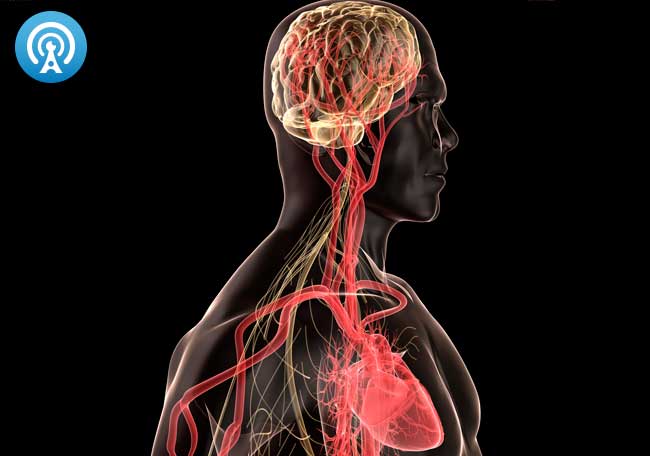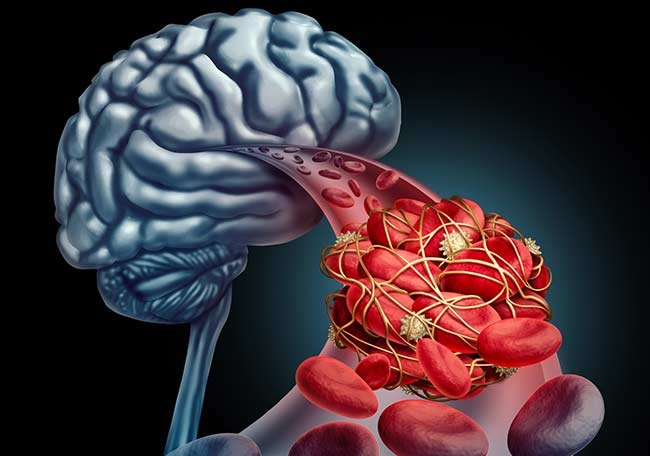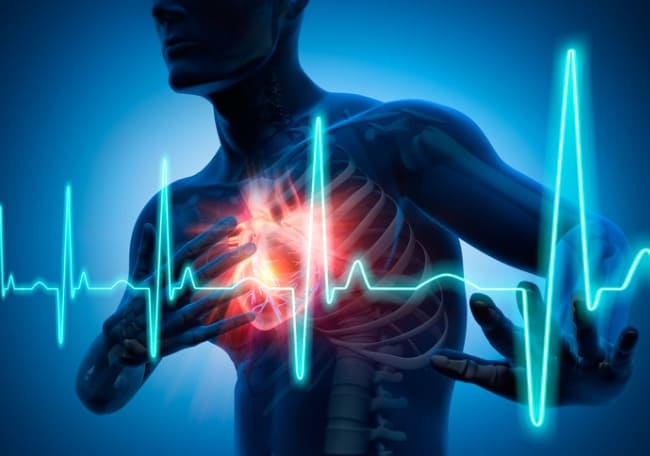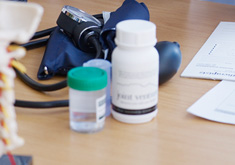Daño cerebral inducido por la insuficiencia cardíaca

Referencias bibliográficas:
1. Bock JS, Gottlieb SS. Cardiorenal syndrome: new perspectives. Circulation 2010; 121:2592–600.
2. Samsky MD, Patel CB, DeWald TA, et al. Cardiohepatic interactions in heart failure: an overview and clinical implications. J Am Coll Cardiol 2013; 61:2397–405.
3. Yancy CW, Jessup M, Bozkurt B, et al. 2013 ACCF/AHA guideline for the management of heart failure: a report of the American College of Cardiology Foundation/American Heart Association Task Force on Practice Guidelines. J Am Coll Cardiol 2013; 62:e147–239.
4. Ferris EB Jr.. Objective measurement of relative intracranial blood flow in man: with observations concerning the hydrodynamics of the craniovertebral system. Arch NeurPsych 1941; 46:377–401.
5. Gruhn N, Larsen FS, Boesgaard S, et al. Cerebral blood flow in patients with chronic heart failure before and after heart transplantation. Stroke 2001;32:2530–3.
6. Serrador JM, Picot PA, Rutt BK, et al. MRI measures of middle cerebral artery diameter in conscious humans during simulated orthostasis. Stroke 2000; 31:1672–8.
7. Lassen NA. Cerebral blood flow and oxygen consumption in man. Physiol Rev 1959; 39:183–238.
8. Rapela CE, Green HD. Autoregulation of canine cerebral bloodflow. Circ Res 1964; 15 Suppl:205–12.
9. MacKenzie ET, Farrar JK, Fitch W, et al. Effects of hemorrhagic hypotension on the cerebral circulation. I. Cerebral blood flow and pial arteriolar caliber. Stroke 1979; 10: 711–8.
10. Symon L, Held K, Dorsch NW. A study of regional autoregulation in the cerebral circulation to increased perfusion pressure in normocapnia and hypercapnia. Stroke 1973; 4:139–47.
11. Sercombe R, Lacombe P, Aubineau P, et al. Is there an active mechanism limiting the influence of the sympathetic system on the cerebral vascular bed? Evidence for vasomotor escape from sympathetic stimulation in the rabbit. Brain Res 1979; 164:81–102.
12. Rajagopalan B, Raine AE, Cooper R, et al. Changes in cerebral blood flow in patients with severe congestive cardiac failure before and after captopril treatment. Am J Med 1984; 76:86–90.
13. Georgiadis D, Sievert M, Cencetti S, et al. Cerebrovascular reactivity is impaired in patients with cardiac failure. Eur Heart J 2000; 21:407–13.
14. Derdeyn CP, Videen TO, Yundt KD, et al. Variability of cerebral blood volume and oxygen extraction: stages of cerebral haemodynamic impairment revisited. Brain 2002; 125:595–607.
15. Lorenzi-Filho G, Azevedo ER, Parker JD, et al. Relationship of carbon dioxide tension in arterial blood to pulmonary wedge pressure in heart failure. Eur Respir J 2002; 19:37–40.
16. Roman DD, Kubo SH, Ormaza S, et al. Memory improvement following cardiac transplantation. J Clin Exp Neuropsychol 1997; 19:692–7.
17. Lanzarone E, Gelmini F, Tessari M, et al. Preservation of endothelium nitric oxide release by pulsatile flow cardiopulmonary bypass when compared with continuous flow. Artif Organs 2009; 33:926–34.
18. Cornwell WK III, Tarumi T, Aengevaeren VL, et al. Effect of pulsatile and nonpulsatile flow on cerebral perfusion in patients with left ventricular assist devices. J Heart Lung Transplant 2014; 33:1295–303.
19. Potapov EV, Dranishnikov N, Morawietz L, et al. Arterial wall histology in chronic pulsatile flow and continuous-flow device circulatory support. J Heart Lung Transplant 2012; 31:1171–6.
20. Busija DW, Heistad DD, Marcus ML. Effects of sympathetic nerves on cerebral vessels during acute, moderate increases in arterial pressure in dogs and cats. Circ Res 1980; 46:696–702.
21. Wei EP, Raper AJ, Kontos HA, et al. Determinants of response of pial arteries to norepinephrine and sympathetic nerve stimulation. Stroke 1975; 6:654–8.
22. Markham DW, Fu Q, Palmer MD, et al. Sympathetic neural and hemodynamic responses to upright tilt in patients with pulsatile and nonpulsatile left ventricular assist devices. Circ Heart Fail 2013; 6:293–9.
23. Almeida OP, Garrido GJ, Beer C, et al. Cognitive and brain changes associated with ischaemic heart disease and heart failure. EurHeart J 2012; 33:1769–76.
24. Vogels RL, Scheltens P, Schroeder-Tanka JM, et al. Cognitive impairment in heart failure: a systematic review of the literature. Eur J Heart Fail 2007; 9:440–9.
25. Sauvé MJ, Lewis WR, Blankenbiller M, et al. Cognitive impairments in chronic heart failure: a case controlled study. J Card Fail 2009; 15:1–10.
26. Huijts M, van Oostenbrugge RJ, Duits A, et al. Cognitive impairment in heart failure: results from the Trial of Intensified versus standard Medical therapy in Elderly patients with Congestive Heart Failure (TIME-CHF) randomized trial. Eur J Heart Fail 2013;15:699–707.
27. Athilingam P, D’Aoust RF, Miller L, et al. Cognitive profile in persons with systolic and diastolic heart failure. Congest Heart Fail 2013; 19:44–50.
28. Cameron J, Worrall-Carter L, Page K, et al. Does cognitive impairment predict poor self-care in patients with heart failure? Eur J Heart Fail 2010;12:508–15.
29. Hawkins LA, Kilian S, Firek A, et al. Cognitive impairment and medication adherence in outpatients with heart failure. Heart Lung 2012; 41: 572–82.
30. RutledgeT,ReisVA, Linke SE, et al.Depression in heart failure: a meta-analytic review of prevalence, intervention effects, and associations with clinical outcomes. J Am Coll Cardiol 2006; 48:1527–37.
31. Huynh QL, Negishi K, Blizzard L, et al. Predictive score for 30-day readmission or death in heart failure. JAMA Cardiol 2016; 1:362–4.
32. Vogels RL, van der Flier WM, van Harten B, et al. Brain magnetic resonance imaging abnormalities in patients with heart failure. Eur J Heart Fail 2007; 9:1003–9.
33. Pan A, Kumar R, Macey PM, et al. Visual assessment of brain magnetic resonance imaging detects injury to cognitive regulatory sites in patients with heart failure. J Card Fail 2013; 19:94–100.
34. Román GC. Brain hypoperfusion: a critical factor in vascular dementia. Neurol Res 2004; 26:454–8.
35. Jefferson AL, Himali JJ, Beiser AS, et al. Cardiac index is associated with brain aging: the Framingham Heart Study. Circulation 2010; 122:690–7.
36. Shimizu A, Sakurai T, Mitsui T, et al. Left ventricular diastolic dysfunction is associated with cerebral white matter lesions (leukoaraiosis) in elderly patients without ischemic heart disease and stroke. Geriatr Gerontol Int 2014; 14 Suppl 2:71–6.
37. van den Hurk K, Reijmer YD, van den Berg E, et al. Heart failure and cognitive function in the general population: the Hoorn Study. Eur J Heart Fail 2011; 13:1362–9.
38. Weber T, Wassertheurer S, O’Rourke MF, et al. Pulsatile hemodynamics in patients with exertional dyspnea: potentially of value in the diagnostic evaluation of suspected heart failure with preserved ejection fraction. J Am Coll Cardiol 2013; 61:1874–83.
39. Borlaug BA, Koepp KE, Melenovsky V. Sodium nitrite improves exercise hemodynamics and ventricular performance in heart failure with preserved ejection fraction. J Am Coll Cardiol 2015; 66:1672–82.
40. Schmidt R, Fazekas F, Offenbacher H, Dusleag J, Lechner H. Brain magnetic resonance imaging and neuropsychologic evaluation of patients with idiopathic dilated cardiomyopathy. Stroke 1991; 22:195–9.
41. Ovbiagele B, Saver JL. Cerebral white matter hyperintensities on MRI: current concepts and therapeutic implications. Cerebrovasc Dis 2006; 2:83–90.
42. Newcomer JW, Selke G, Melson AK, et al. Decreased memory performance in healthy
humans induced by stress-level cortisol treatment. Arch Gen Psychiatry 1999; 56:527–33.
Comentarios
Para ver los comentarios de sus colegas o para expresar su opinión debe ingresar con su cuenta de IntraMed.















